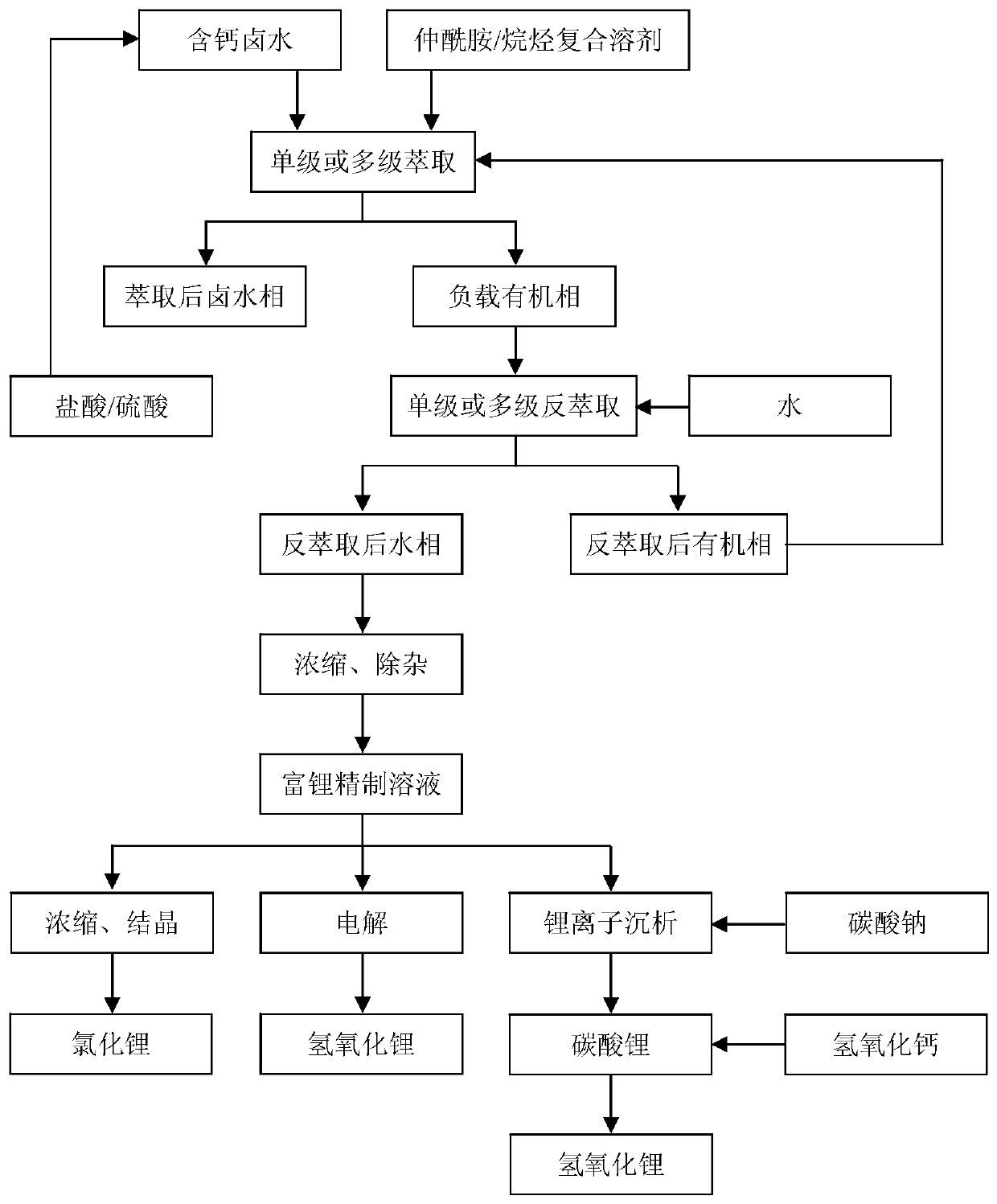Extraction system and method for separating calcium and extracting lithium from calcium-containing brine through secondary amide/alkane compound solvent and application thereof
A composite solvent and secondary amide technology, which is applied in the field of extraction systems for separating calcium from calcium-containing brine with composite solvent to extract lithium, can solve the limitation of the decrease in the mass ratio of calcium to lithium, the failure to develop lithium resources, and the difficulty of separation and separation, etc. problems, to achieve the effect of improving viscosity, easy production, and simple molecular structure
- Summary
- Abstract
- Description
- Claims
- Application Information
AI Technical Summary
Problems solved by technology
Method used
Image
Examples
Embodiment 1
[0052] Li in a calcium-containing brine + and Ca 2+ The contents are 3.29g / L and 187.85g / L respectively, and the mass ratio of calcium to lithium is 57.10:1, of which Na + 、K + , Mg 2+ , Cl - and B 2 o 3 The contents are 2.90, 19.69, 2.14, 377.80 and 1.56g / L respectively, and the brine density is 1.41g / cm 3 , the pH value of the brine is 2.5, and the ion concentration in the brine is prepared according to the brine composition of an oilfield in Nanyishan, Qaidam Basin, Qinghai. The oilfield brine is degreased by an oil-water separator in advance. Get 6mL of this kind of brine in the 100mL ground mouth Erlenmeyer flask, then add 24mL N-isooctyl isovaleramide therein as extractant and 6mL tetradecane as diluent, diluent accounts for 20% of organic phase volume, organic The volume ratio of phase to calcium-containing brine is 5:1. Put magnets in the Erlenmeyer flask, insert the matching air condenser into the mouth of the flask to prevent the liquid from splashing out, pl...
Embodiment 2
[0059] Get 24mL N-amyl isononamide as extractant and 6mL 260# solvent naphtha as diluent in 100mL conical flask with ground mouth, diluent occupies 20% of organic phase volume, then adds 6mL in the embodiment 1 wherein For calcium-containing brine, the volume ratio of organic phase to calcium-containing brine is 5:1. Put magnets in the Erlenmeyer flask, insert the matching air condenser into the mouth of the flask to prevent the liquid from splashing out, place it in a DF-101S collector type constant temperature heating magnetic stirrer, mix and stir at 20°C, and extract for 30 minutes. Then the mixed liquid was transferred to a 100mL plastic test tube, and centrifuged in an LD5-10 desktop centrifuge at a speed of 4000r / min for 10min. The interface between the two phases was clear. After phase separation, the loaded organic phase after extraction and the remaining brine phase were obtained. Transfer the loaded organic phase to another 100mL ground-mouth Erlenmeyer flask, add d...
Embodiment 3
[0065]Get 30mL N-pentyl isononamide as extractant and 30mL dodecane (mixture of isomers) as diluent in 100mL ground mouth Erlenmeyer flask, diluent occupies 50% of organic phase volume, then in it Add 6 mL of the calcium-containing brine in Example 1, the pH of the brine is 6.6, and the volume ratio of the organic phase to the calcium-containing brine is 10:1. Put magnets in the Erlenmeyer flask, insert the matching air condenser into the mouth of the flask to prevent the liquid from splashing out, place it in a DF-101S collector type constant temperature heating magnetic stirrer, mix and stir at 20°C, and extract for 30 minutes. Then the mixed liquid was transferred to a 100mL plastic test tube, and centrifuged in an LD5-10 desktop centrifuge at a speed of 4000r / min for 10min. The interface between the two phases was clear. After phase separation, the loaded organic phase after extraction and the remaining brine phase were obtained. Transfer the loaded organic phase to anothe...
PUM
 Login to View More
Login to View More Abstract
Description
Claims
Application Information
 Login to View More
Login to View More - Generate Ideas
- Intellectual Property
- Life Sciences
- Materials
- Tech Scout
- Unparalleled Data Quality
- Higher Quality Content
- 60% Fewer Hallucinations
Browse by: Latest US Patents, China's latest patents, Technical Efficacy Thesaurus, Application Domain, Technology Topic, Popular Technical Reports.
© 2025 PatSnap. All rights reserved.Legal|Privacy policy|Modern Slavery Act Transparency Statement|Sitemap|About US| Contact US: help@patsnap.com



